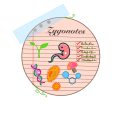Experiment 1:
Aim:
To prepare a temporary mount of a leaf peel to show stomata.
Materials Required:
- Fresh leaf (e.g., Rhoeo, Tradescantia, or Zebrina)
- Forceps
- Blade or needle
- Glass slide and cover slip
- Glycerine
- Safranin (optional stain)
- Dropper
- Microscope
- Brush
Procedure:
- Take a fresh leaf and tear it carefully to get a thin, transparent peel from the lower surface.
- Place the peel in water to prevent it from drying.
- Transfer the peel to a clean glass slide using a brush or forceps.
- Add a drop of glycerine to the peel.
- Gently place a cover slip over the peel using a needle (to avoid air bubbles).
- Remove excess glycerine using blotting paper.
- Observe the slide under the microscope (first under low power, then high power).
Observations:
- You will see small pores (stomata) surrounded by kidney-shaped guard cells on the peel.
Result:
- Stomata are present on the lower surface of the leaf.
- Each stoma is surrounded by two kidney-shaped guard cells which control the opening and closing of the pore.
Precautions:
- Use a fresh and healthy leaf.
- Avoid folding or overlapping the peel.
- Place the cover slip gently to prevent air bubbles.
- Handle the microscope carefully.
Viva Voce Questions & Answers
1. What is a stoma?
A stoma (plural: stomata) is a tiny pore present on the leaf surface, used for gas exchange.
2. What are guard cells?
Guard cells are two specialized kidney-shaped cells that surround a stoma and regulate its opening and closing.
3. Where are stomata generally more numerous—upper or lower surface?
Lower surface, especially in dicot leaves.
4. What is the function of stomata?
They help in exchange of gases (CO₂ and O₂) and transpiration (water loss).
5. Why is glycerine used while preparing the slide?
It keeps the leaf peel moist and prevents it from drying.
6. Why is a cover slip used?
To protect the specimen and lens, and to avoid air bubbles.
7. What happens to stomata in dry conditions?
Guard cells close the stomata to reduce water loss.
8. Which type of microscope is used for this experiment?
A compound microscope.
